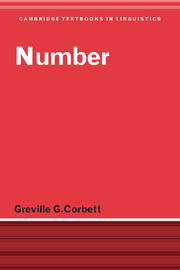Book contents
- Frontmatter
- Contents
- List of figures
- List of tables
- Preface
- List of abbreviations
- 1 Introduction
- 2 Meaning distinctions
- 3 Items involved in the nominal number system
- 4 Integrating number values and the Animacy Hierarchy
- 5 The expression of number
- 6 The syntax of number
- 7 Other uses of number
- 8 Verbal number
- 9 Conclusion and new challenges
- References
- Author index
- Language index
- Subject index
6 - The syntax of number
Published online by Cambridge University Press: 05 June 2012
- Frontmatter
- Contents
- List of figures
- List of tables
- Preface
- List of abbreviations
- 1 Introduction
- 2 Meaning distinctions
- 3 Items involved in the nominal number system
- 4 Integrating number values and the Animacy Hierarchy
- 5 The expression of number
- 6 The syntax of number
- 7 Other uses of number
- 8 Verbal number
- 9 Conclusion and new challenges
- References
- Author index
- Language index
- Subject index
Summary
We saw in the last chapter that agreement is one of the ways of expressing number and this will be our main topic here. We first consider agreement and the types of mismatch which occur between the controlling noun phrase and the agreement target. Then we undertake a set of case studies leading to a typology of agreement options in number. There are three typological themes: once again we see the importance of being clear about terms, as we analyse systems where the number values of controller and target differ; we see the importance of hierarchies, this time in syntax; and there is a graphic illustration of how factors which can be identified as being at work in various languages interact in different ways to give very different results.
Controller versus target number
The first notion that we need is ‘agreement’, which is the covariance or matching of feature specifications between two separate elements, such as subject noun phrase and verb. We shall call the element which determines the agreement (say the subject noun phrase) the controller. The element whose form is determined by agreement is the target. The syntactic environment in which agreement occurs is the domain of agreement. And when we indicate in what respect there is agreement, we are referring to agreement categories or agreement features, as illustrated in figure 6.1. Of course, we are primarily interested in agreement in number. The controller of agreement is a noun phrase. Cross-linguistically, the possible targets are more varied than many believe.
- Type
- Chapter
- Information
- Number , pp. 178 - 218Publisher: Cambridge University PressPrint publication year: 2000



